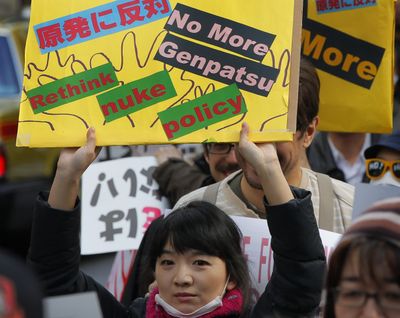Radiation troubles grow
Seawater farther from plant may be contaminated

TOKYO – Highly radioactive iodine seeping from Japan’s damaged nuclear complex may be making its way into seawater farther north of the plant than previously thought, officials said today, adding to radiation concerns as the crisis stretches into a third week.
Mounting problems, including badly miscalculated radiation figures and no place to store dangerously contaminated water, have stymied emergency workers struggling to cool down the overheating plant and avert a disaster with global implications.
The coastal Fukushima Dai-ichi power plant, located 140 miles northeast of Tokyo, has been leaking radiation since a magnitude-9.0 quake on March 11 triggered a tsunami that engulfed the complex. The wave knocked out power to the system that cools the dangerously hot nuclear fuel rods.
Today, workers resumed the laborious yet urgent task of pumping out the hundreds of tons of radioactive water inside several buildings at the six-unit plant. The water must be removed and safely stored before work can continue to power up the plant’s cooling system, nuclear safety officials said.
The contaminated water, discovered last Thursday, has been emitting radiation that measured more than 1,000 millisieverts per hour in a recent reading at Unit 2 – some 100,000 times normal amounts, plant operator Tokyo Electric Power Co. said.
As officials scrambled to determine the source of the radioactive water, Chief Cabinet Secretary Yukio Edano repeated today that the contaminated water in Unit 2 appeared to be due to a temporary partial meltdown of the reactor core.
He called it “very unfortunate” but said the spike in radiation appeared limited to the unit.
However, new readings show contamination in the ocean has spread about a mile farther north of the nuclear site than before. Radioactive iodine-131 was discovered just offshore from Unit 5 and Unit 6 at a level 1,150 times higher than normal, Hidehiko Nishiyama, a spokesman for the Nuclear and Industrial Safety Agency, told reporters today.
He had said earlier there was no link between the radioactive water leaking inside the plant and the radiation in the sea. Today, though, he reversed that position, saying he does suspect that radioactive water from the plant may indeed be leaking into the ocean.
Closer to the plant, radioactivity in seawater tested about 1,250 times higher than normal last week and climbed to 1,850 times normal over the weekend. Nishiyama said the increase was a concern, but also said the area is not a source of seafood and that the contamination posed no immediate threat to human health.
Up to 600 people are working inside the plant in shifts. Nuclear safety officials say workers’ time inside the crippled units is closely monitored to minimize their exposure to radioactivity, but two workers were hospitalized Thursday when they suffered burns after stepping into contaminated water. They were to be released from the hospital today.
Confusion at the plant has intensified fears that the nuclear crisis will last weeks, months or years amid alarms over radiation making its way into produce, raw milk and even tap water as far as Tokyo.
On Sunday, TEPCO officials said radiation in leaking water in the Unit 2 reactor was 10 million times above normal – an apparent spike that sent employees fleeing the unit. The day ended with officials saying the huge figure had been miscalculated and offering apologies.
“The number is not credible,” TEPCO spokesman Takashi Kurita said late Sunday. “We are very sorry.”
A few hours later, TEPCO Vice President Sakae Muto said a new test had found radiation levels 100,000 times above normal – far better than the first results, though still very high.
But he ruled out having an independent monitor oversee the various checks despite the errors.
Muto acknowledged it could take a long time to clean up the Fukushima complex.
“We cannot say at this time how many months or years it will take,” he said.
A poll, meanwhile, showed that support for Japan’s prime minister had risen amid the disasters.
The poll conducted over the weekend by Kyodo News agency found that approval of Prime Minister Naoto Kan and his Cabinet rose to 28.3 percent after sinking below 20 percent in February, before the earthquake.
Last month’s low approval led to speculation that Kan’s days were numbered. While the latest figure is still low, it suggests he is making some gains with voters.
About 58 percent of respondents in the nationwide telephone survey of 1,011 people said they approved of the government’s handling of the earthquake and tsunami, but a similar number criticized its handling of the nuclear crisis.
The death toll from the disasters stood at 10,668 Sunday, with 16,574 people missing, police said. Hundreds of thousands of people are homeless.